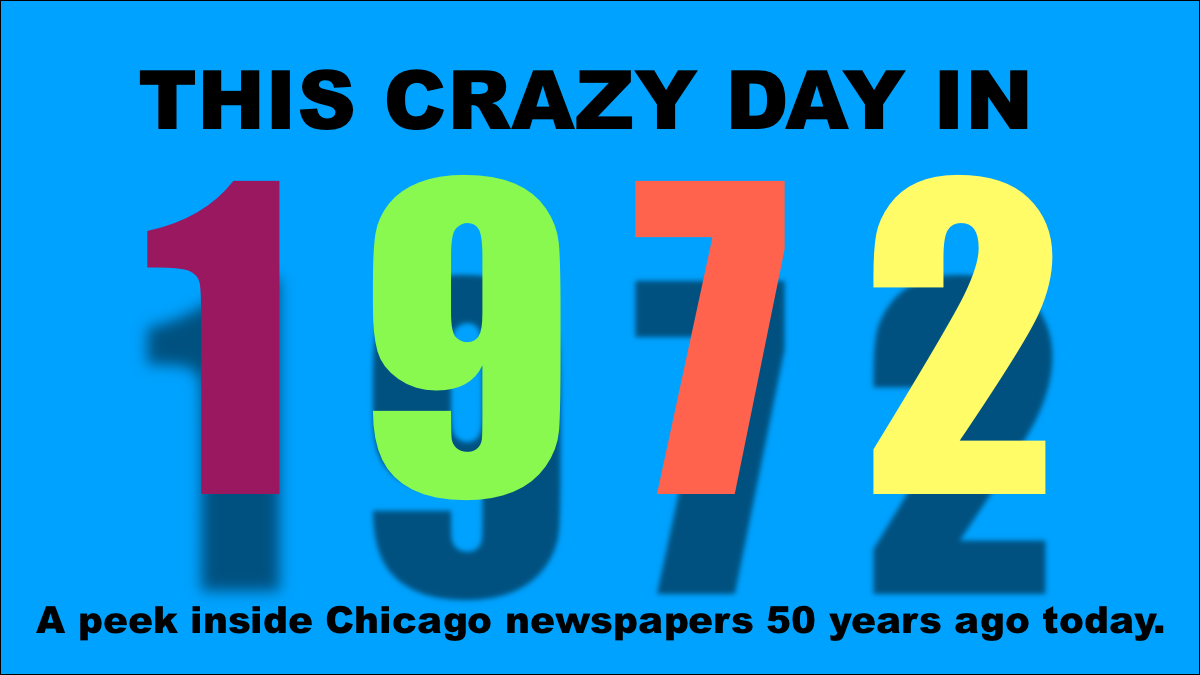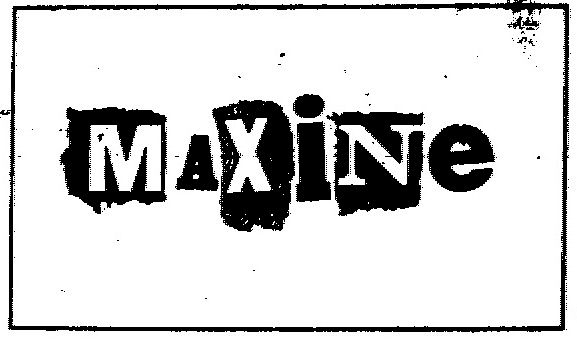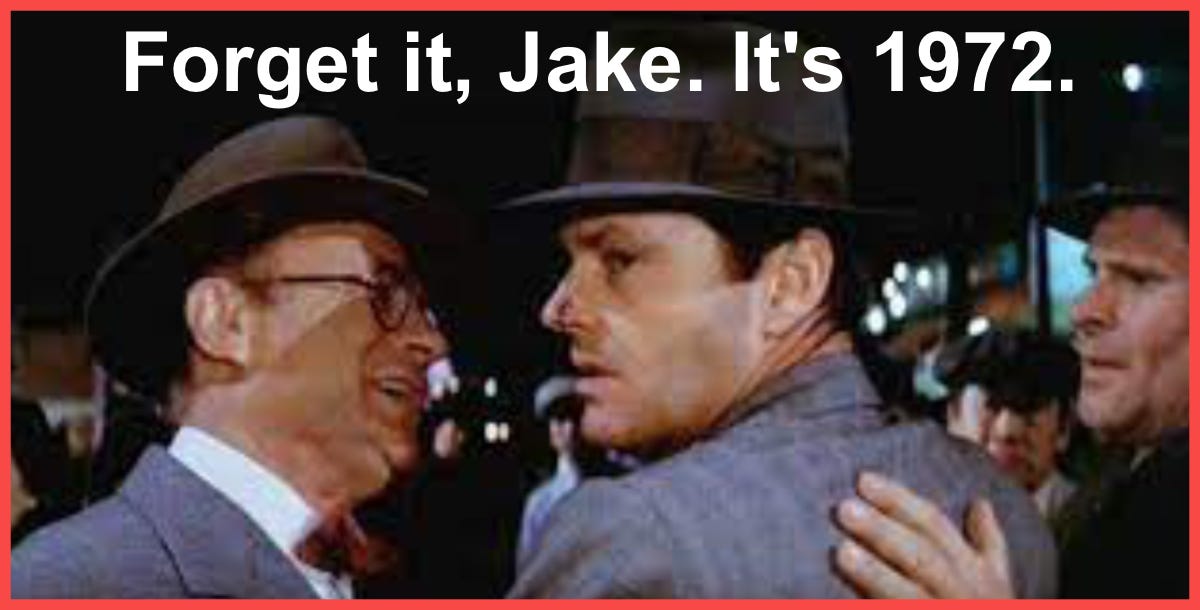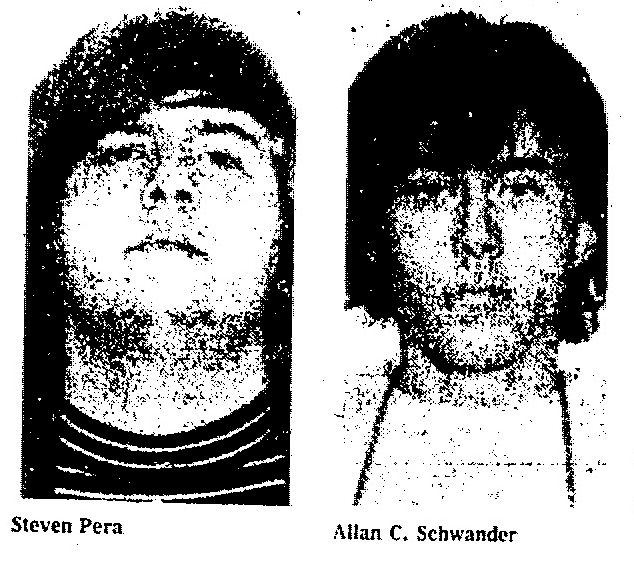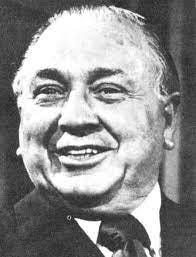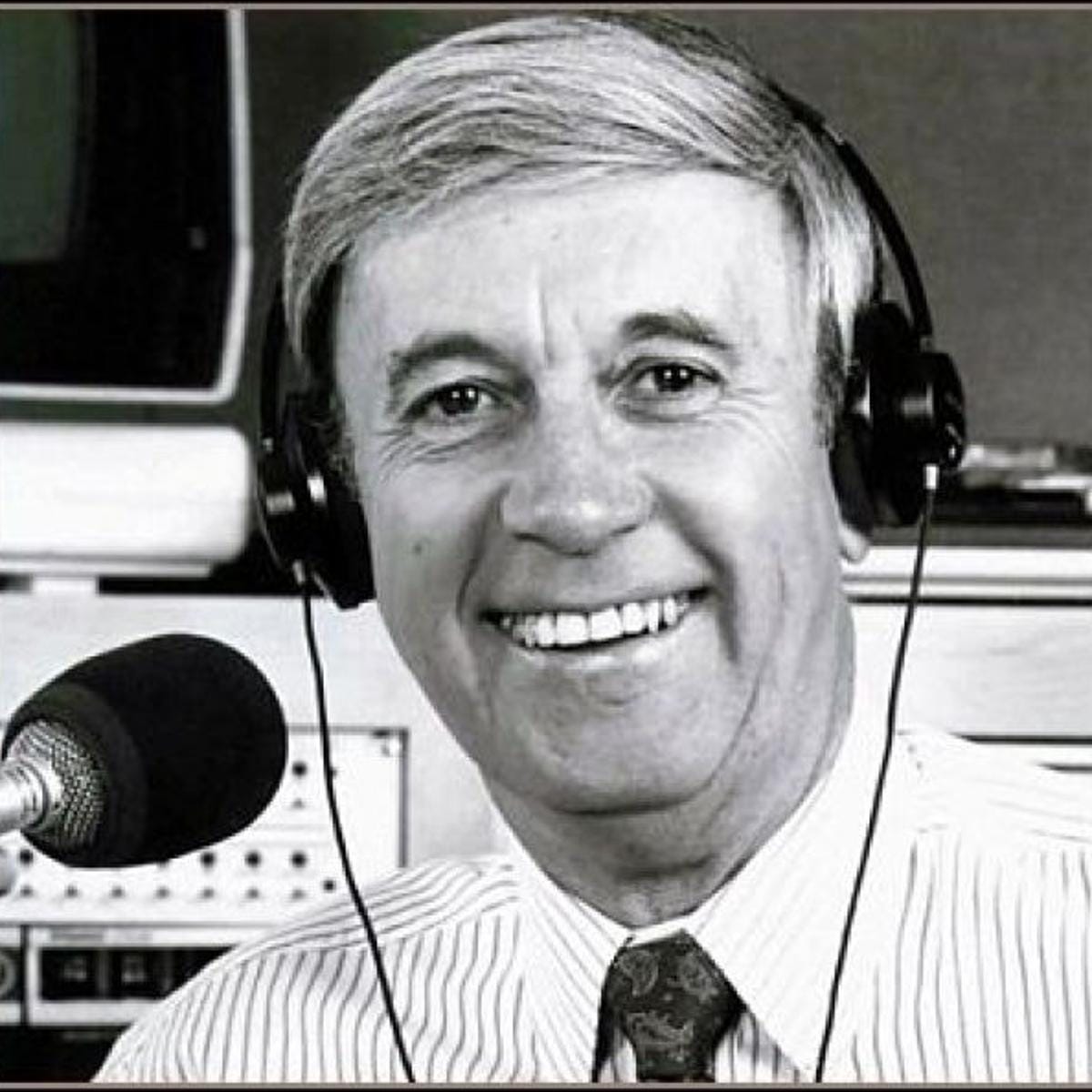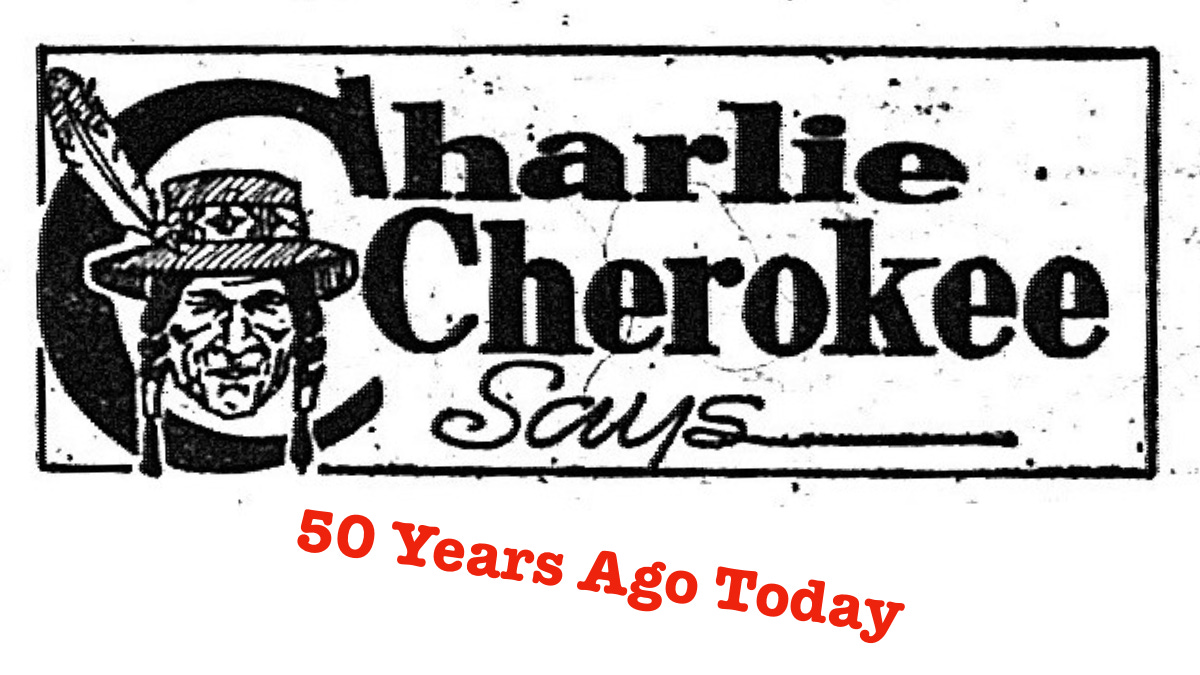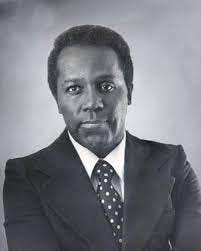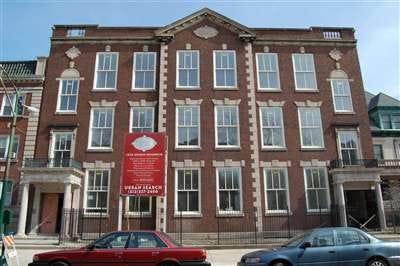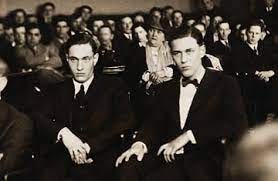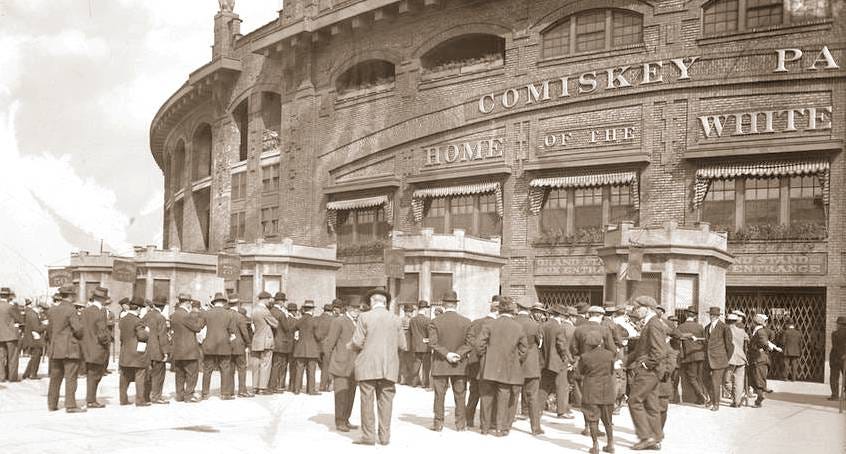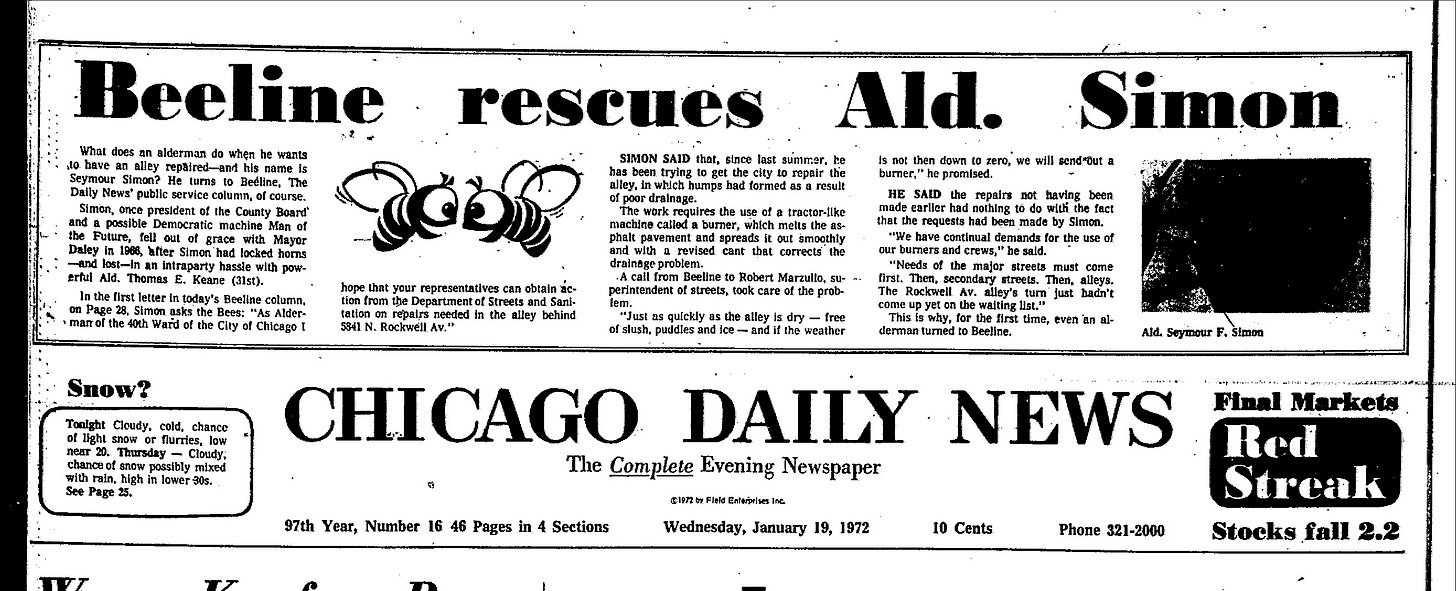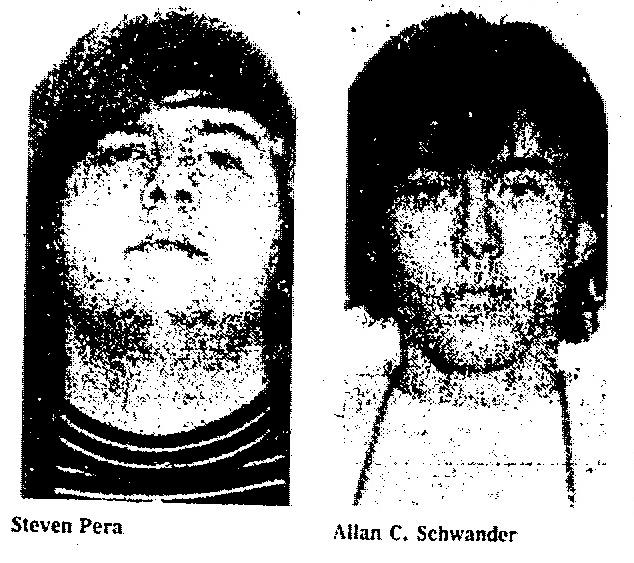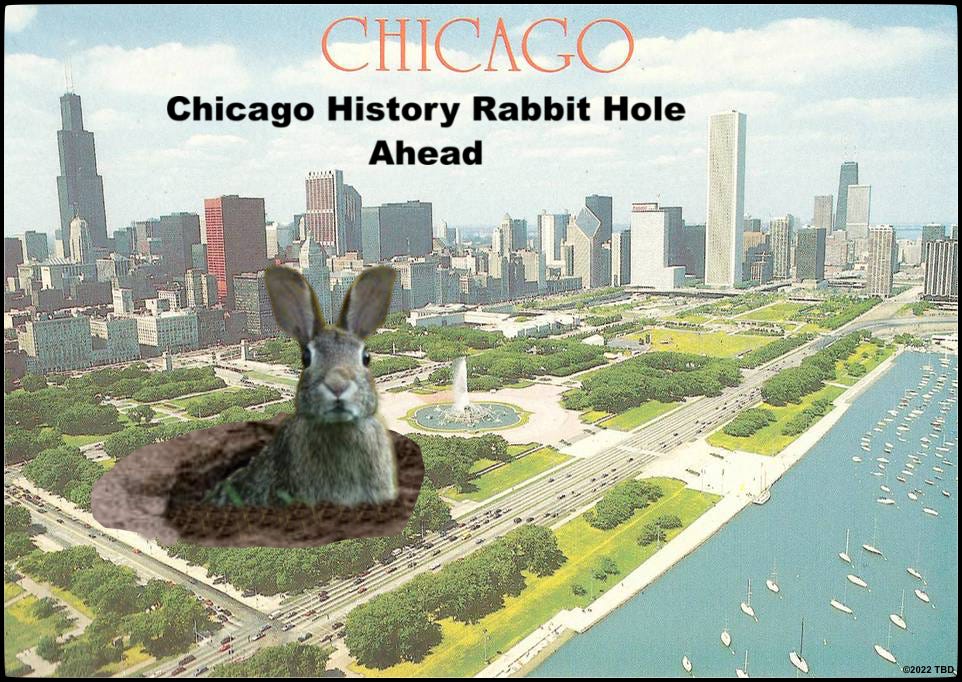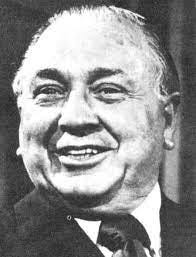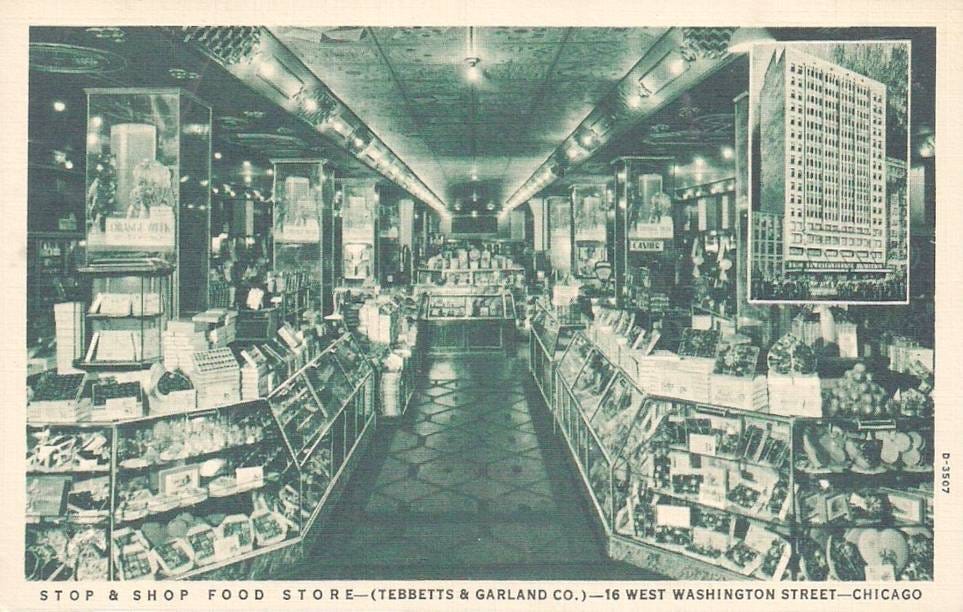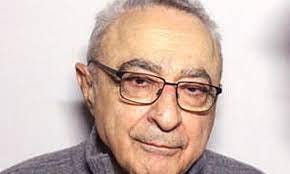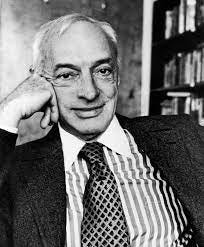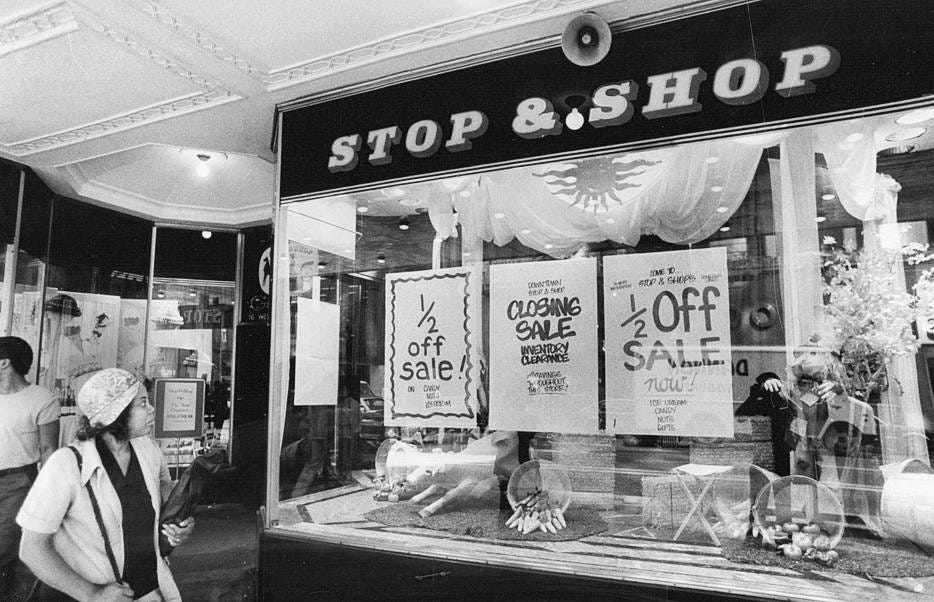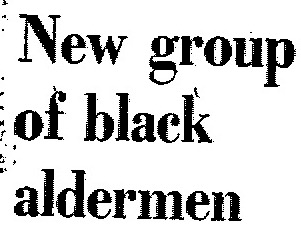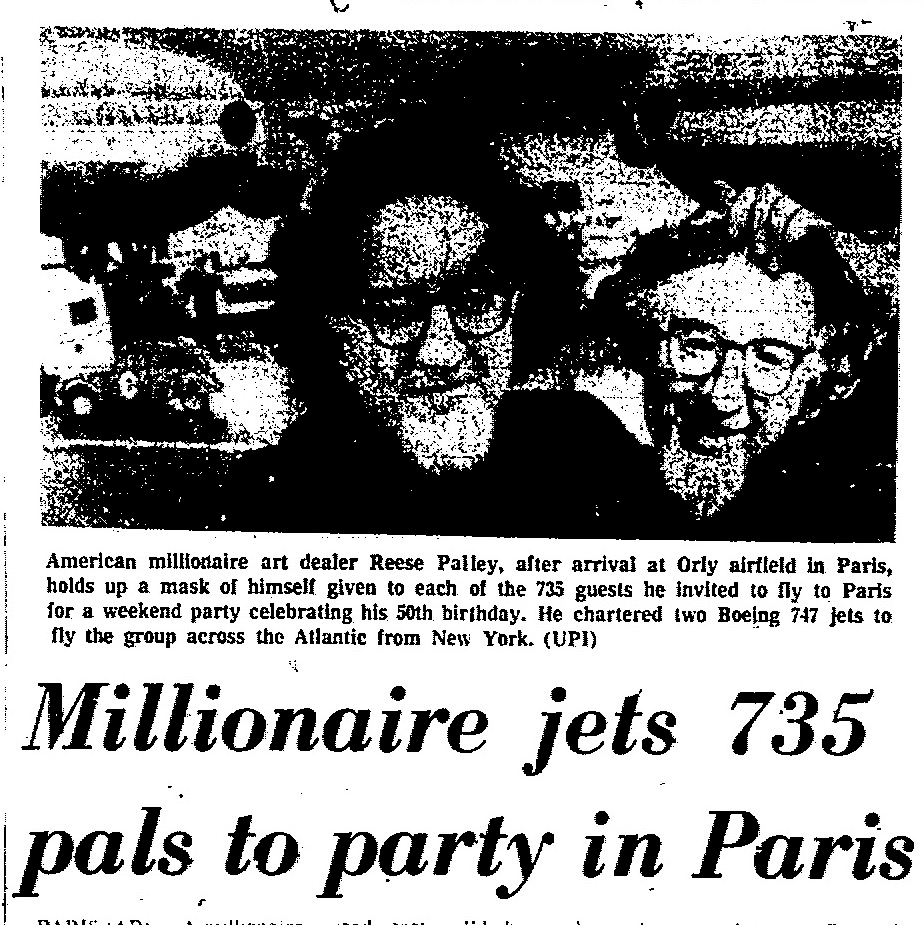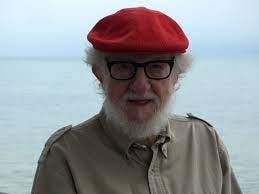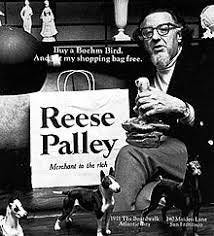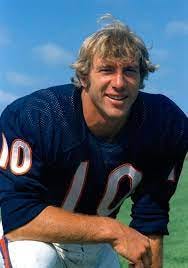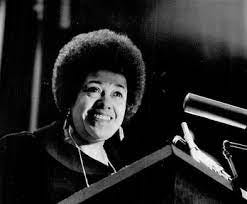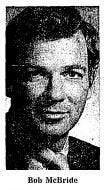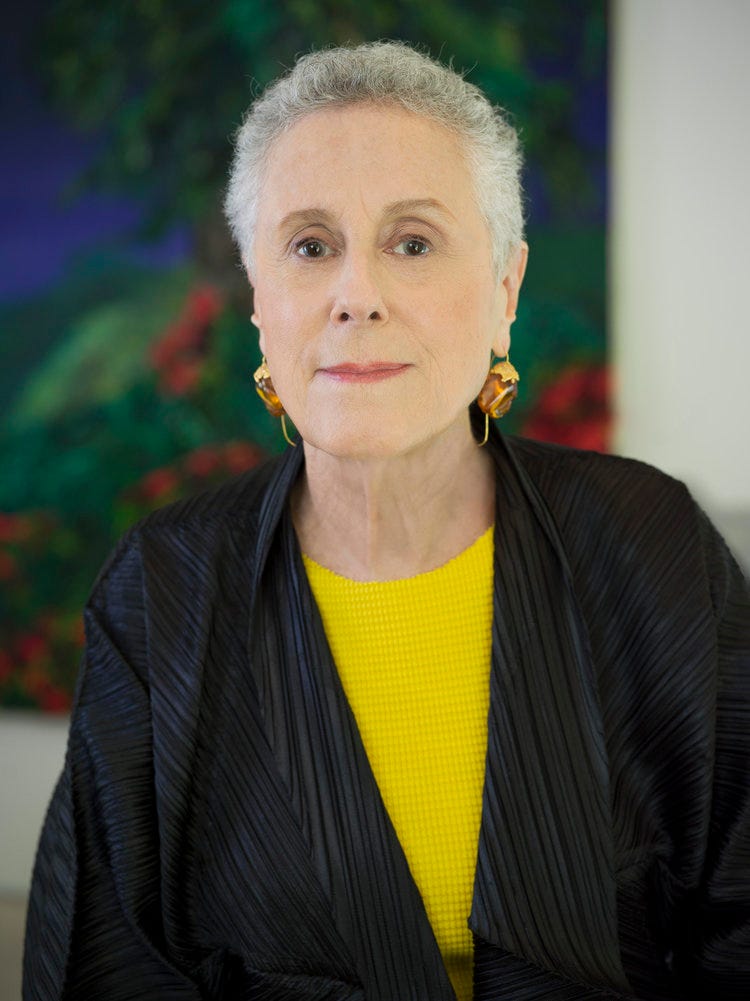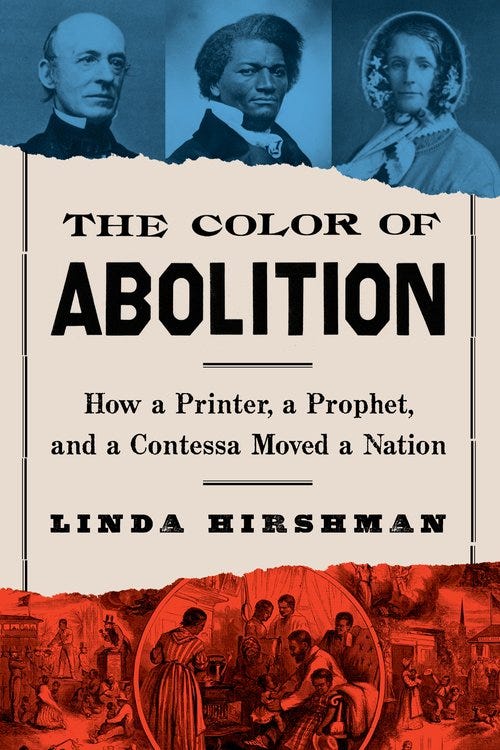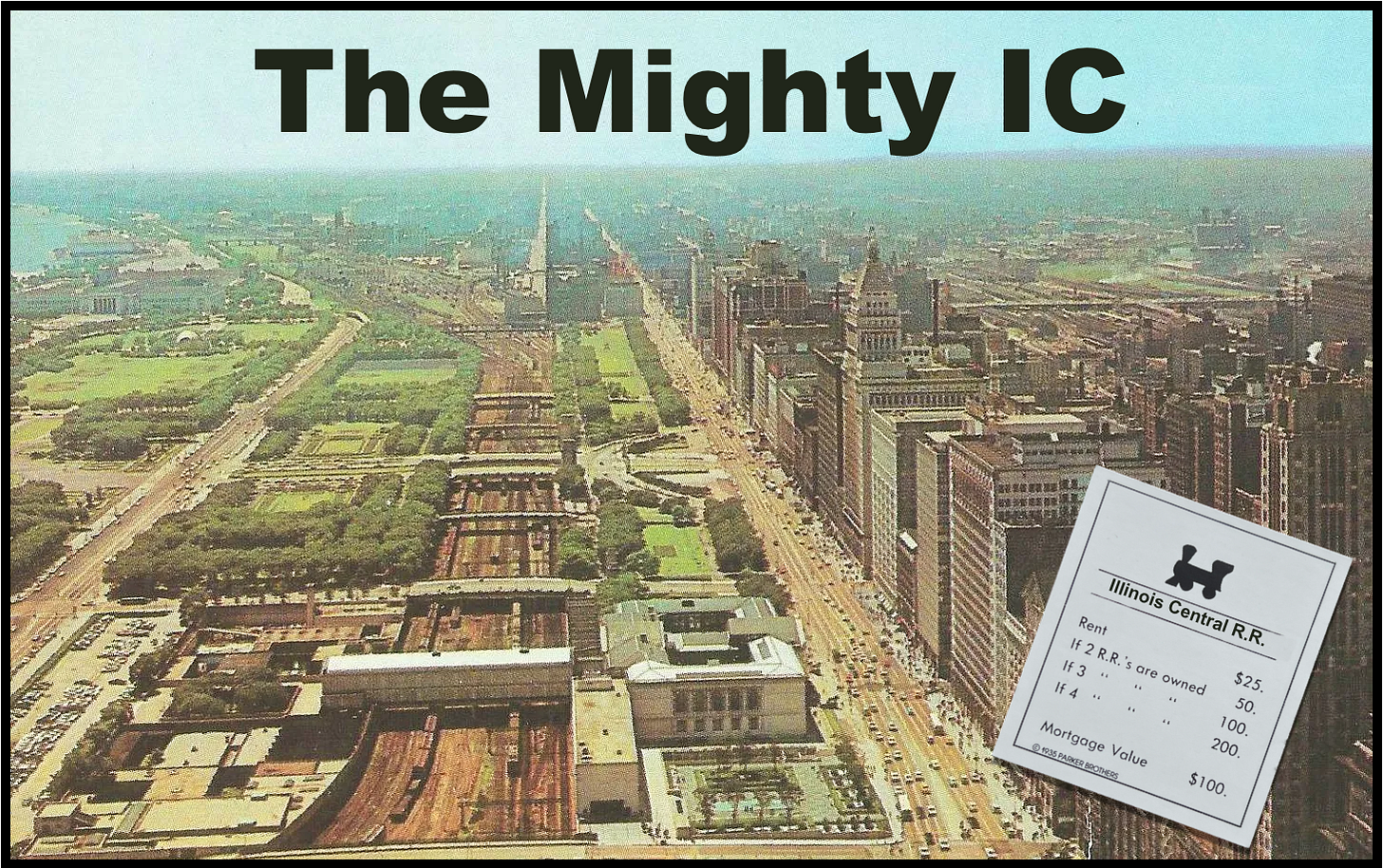THIS CRAZY DAY IN 1972: Don't drink the water
Weekly compilation, January 17-23, 1972
To access all website contents, click HERE.
Why do we run this separate item peeking into newspapers from 1972? Because 1972 was part of the ancient times when everybody read a paper. Everybody, everybody, everybody. Even kids. So Steve Bertolucci, the 10-year-old hero of the novel serialized at this Substack, read the paper too—sometimes just to have something to do. These are some of the stories he read. If you’d like, keep up with the 1972 papers every day on Twitter, @RoselandChi1972.
January 17, 1972
Chicago Daily News: Dear Maxine
I’m still amazed that the Daily News had no advice columnist before today—when Maxine moves into her regular spot in the “everyday” section. What 1972 problems will she solve?
We may have to use the following message every time we feature Maxine. We definitely need it today. Anyone under, hm, 50, may need smelling salts.
“DEAR MAXINE: My boss is a really good guy—when he’s sober. But lately he’s begun to have trouble at home. It smells like divorce. The last few months he’s been coming into the office after extended lunch hours where meals were obviously liquid.”
This is going exactly where you think it is.
“At such times he calls me in for dictation and either finds some reason to touch me or make some slightly improper remark.”
“…He has not gotten far enough out of line for me to know quite how to handle the situation, but I’m very uncomfortable about the whole thing. This is the best job I’ve ever had and the pay is good. How can I maintain the proper distance and keep the job?—Secretary with a Problem”
Sue his ass now! Oh wait, Maxine is the 1972 advice columnist here. Let's see what she says.
“DEAR SECRETARY: Ignore his remarks and slide past the passes if possible. If later, when his home troubles are resolved, his misconduct continues, you’ll have to face the fact that the good-guy boss just isn’t anymore, and start looking. Maybe, though, he’ll remember the value of your earlier businesslike arrangement, and straighten out.”
Need help getting up? Let me give you a hand.
In fairness to Maxine though, this is what many people would have said in 1972. As I like to remind everyone now and then: 1972 is so much better when you can leave anytime you want.
January 18, 1972
Chicago Daily News: Foil plot to poison water, seize ‘master race’ pair
Daley, Aides give assurance
By Arthur J. Snider
Suspect appeared to be typical student
By Karen Hasman and Phillip J. O’Connor
In what must be the most bizarre almost-terrorist incident in the city’s history, two Chicago City College students were arrested for “an alleged plot to poison the city’s water supply and possibly the Fort Sheridan military complex” with bacteria they were growing in a lab at the Mayfair campus (now Truman College).
Steve Pera, 18, of Evanston and Allen Schwander, 19, of Chicago were accused of organizing “a group known as ‘RISE’ “ and “charged with conspiracy to commit mass murder.”
“State’s Attorney Edward V. Hanrahan said members of RISE apparently were inocculated or were to be immunized against the disabling effects of bacterial poisonings so they could survive to form the basis of a new master race.”
Local police and the FBI investigated after learning “late last week of the plot to poison the water with bacterial cultures by an aerial bombing.” The main target was the Central Filtration Plant at 1000 E. Ohio, now known as the Jardine Water Purification Plant.
“Steve Pera didn’t arouse any special interest among the officials of the Mayfair branch of Chicago City College when he decided to drop four courses and concentrate on a special biology project offering one-hour credit,” write Karen Hasman and Phillip J. O’Connor. They were surprised when the FBI showed up to confiscate evidence from the lab where Pera was growing various bacteria cultures.
The state’s attorney’s office said “the two long-haired youth” were an “extreme danger to the community”. Schwander’s apartment at 6501 N. Fairfield “was described as a ‘war office’ by a police source”, including a substance “identified as typhoid micro-organisms”.
“A woman who lived in the building where the two young men were arrested, was shocked by the disclosure. ‘Did you say poison? In our building? Oh, my God,’ exclaimed Mrs. Florine Buyers, 80, of 6501 N. Fairfield.”
The landlord’s daughter “told a Daily News reporter that several long-haired young men visited the apartment almost every night.’”
Mayor Daley and the Chicago Health Dept “assured residents Tuesday that despite wild reports of a plot to poison the water, there has been no bacteria placed in the lake.” Mayor Daley held a press conference with City Water Commissioner James Jardine to calm everyone down after hundreds of Chicagoans called City Hall and the police department asking about whether Lake Michigan water was safe.
’I’d like to assure everyone that the water is safe,’ Daley said. ‘All the necessary steps have been taken in the past and will be taken in the future to keep the water supply safe.’”
City Water Commissioner James Jardine “scoffed” at the alleged plot to poison the city’s water. “No attempt was made to poison the water,” he said. “They couldn’t do it if they tried.”
“A University of Chicago toxicology expert said poisoning of Lake Michigan water can occur only in science fiction,” wrote the News. “‘You would need gallons of toxin and the poison can only be produced in microgram amounts even in large biological warfare installations,’ he said.”
Still, the city assured everybody that security and the purification process for drinking water, including chlorination, would protect the lake and water facilities. The city already uses closed-circuit TV and armed police at the Central Water Plant, which we now know as the Jardine Water Purification Plant. “Similar precautions have been taken at the south plant, 79th and the Lake.” The intakes and water cribs are all monitored.
January 18, 1972
Chicago Daily News: Early blackout on water story
By John Linstead
Wally Phillips broke the colossal story about two long-haired city college students arrested for conspiring to poison the city’s drinking water, and then as survivors found a new master race—as if Chicago really were the only place in the whole world, as we Chicagoans often feel it is.
Recall younger readers that Wally Phillips is king of morning radio on WGN, reaching literally 25% of everyone listening to a radio in Chicagoland and beyond, about 1.6 million people. And they're all listening at the same time.
“The city’s residents were aware that something was brewing about 7:30 a.m. Tuesday when radio broadcaster Wally Phillips began telling listeners that WGN Radio had a ‘shocking exclusive’ and compared it with the recent bank bomb plot. WGN broke the story on its 8 a.m. news program, more than eight hours after the two youths were arrested on charges of conspiracy to commit mass murder,” writes Linstead.
“The Daily News began trying to contact public officials when Phillips first announced the ‘exclusive,’ but the officials said nothing.” The main police news office said “news of the arrests could only come from State’s Attorney Edward V. Hanrahan,” and Police Supt. James B. Conlisk refused to talk to reporters. Finally, after a barrage of press, Chicago police released a statement with the basic facts.
When Daily News reporters “finally found Hanrahan at the Civic Center”—now Daley Center—“he said that he only knew what he had heard on the radio and was going to the Criminal Courts Building, W. 26th St., to find out more.”
So in other words, the State’s Attorney learned about the plot from Wally Phillips also? Yeah, that sounds about right.
January 18, 1972
Chicago Daily Defender: All eyes on toilet
No byline
“’If you’re gonna get business, you’ve gotta get peoples’ attention,’ a friend told Willie Johnson a few months ago. Taking this bit of homely advice literally, Johnson, 28, who runs an insurance, tax preparation, and accounting office at 1137 W. 79th, promptly installed an old toilet commode in the window of his storefront office, and business has picked up remarkably.”
“Many have even come in to inquire what it’s doing there all shined up, and in the process Johnson said he has acquired a lot of new business—more than 50 per cent since the new addition. ‘The change was instantaneous,’ he said. ‘People just can’t figure out what it’s doing there…no one ever goes by without looking.’”
1137 W. 79th today. All things must pass.
January 18, 1972
Chicago Daily Defender: Charlie Cherokee Says
Charlie surveys the evolving civil rights scene in Chicago.
And yes, the Defender had run a column called “Charlie Cherokee Says” since the 1940s. As we must sometimes remind younger readers, It’s 1972, Jake. See the January 4 item here for more background.
The scene was shaken up when Rev. Jesse Jackson quit the SCLC’s Operation Breadbasket after SCLC suspended him with pay while it investigated whether Jackson set up nonprofit corporations to run Black Expo without informing SCLC. But everybody knew it was the personal conflict between young up-and- comer Jackson and movement elder SCLC head Rev. Ralph Abernathy.
“The stage has been set in Chicago for a new three-pronged offensive on racism in 1972,” writes Charlie. “The new alignments are represented by shrewd and ambitious men. The Rev. Jesse Jackson has launched PUSH and a new coalition headed by Dr. Charles Hurst, which has its base on the Westside, is called POWER. The third new move is represented by the Rev. C.T. Vivian who heads Operation Breadbasket and has the support of the Rev. Ralph Abernathy of SCLC.”
“This kind of leadership talent in Chicago makes the city unique. In no other city will you find black leadership of this caliber so well prepared to move the masses of the people. Cynics who fear that three-pronged attack on racism may become a three-ringed circus might do well to heed the remark of Mayor Richard Hatcher. When questioned about the relationship between PUSH, on whose board he sits, and SCLC, Hatcher commented, ‘the more hands on the plow the better.’”
”The only cloud on the horizon was the tone of bitterness in the remarks of the Rev. Abernathy when he referred to Jesse Jackson in a press conference here Friday.”
January 18, 1972
Chicago Daily Defender: Charlie Cherokee Says
Part 2
Charlie often mentions what’s going on at Stop & Shop. Why? Stop & Shop was a gourmet food shop at 16 W. Washington, and it was the bomb back then.
Besides the cheeses you saw nowhere else and the wine section, it was the only place in the Loop you could get an ice cream cone on your lunch hour. Here it is in 1957, courtesy John Chuckman on Wordpress. Why does Charlie care about it though?
I think it’s because Stop & Shop was owned by the Hillman’s grocery chain, and Gardner Stern Sr was Hillman’s president. According to Stern’s 1996 Tribune obituary, among his many civic positions, he headed the Chicago chapter of the United Negro College Fund.
A bit more on Gardner Stern: “Born and raised on the South Side, Mr. Stern was the son of attorney Henry R. Stern, who founded the law firm now known as Jenner & Block. He attended the Forrestville School and the Harvard School for Boys and graduated from Yale University in 1926.”
The Harvard School was a private school in Kenwood at 4729 S. Ellis, now transformed into condominiums. It was the alma mater of Richard Loeb of Leopold & Loeb. It’s also the school where the pair lay in wait outside for a victim on May 21, 1924--which turned out to be poor Bobby Franks.
Stern’s father was friends with the old Roman, White Sox owner Charles Comiskey. Stern attended the first game at the old Comiskey Park with his dad in 1910—and brought his grandson to the first game in what I will refer to as the new Comiskey Park no matter what they call it officially. That’s a pretty cool family anecdote.
But the reason I included this today is Charlie’s hilarious reference to Mayor Daley:
“City Treasurer Joseph Bertrand and King Richard will head the dignitaries from City Hall at the ceremony marking the 100th birthday of Stop & Shop tomorrow. Gardner Stern, Sr. will tell of the store’s history. Stop & Shop has pioneered in the field of deluxe food gift packaging.”
January 19, 1972
Chicago Daily News: Beeline rescues Ald. Simon
Remember Beeline, the Daily News consumer column that helps readers do everything from looking up old recipes to getting money back from unscrupulous companies? This is, as far as I know, the only time Beeline ever made the front page. Above the masthead.
Not long ago we read how Beeline sent a reader a detailed map of all the O’Hare runways and information on how to decode the radio chatter about the planes, which seemed like information better left secret. No matter. Today, Beeline makes real honey.
“What does an alderman do when he wants to have an alley repaired—and his name is Seymour Simon?” writes Beeline. “He turns to Beeline, The Daily News’ public service column, of course.”
“Simon, once president of the County Board and a possible Democratic machine Man of the Future, fell out of grace with Mayor Daley in 1966, after Simon had locked horns—and lost—in an intraparty hassle with powerful Ald. Thomas E. Keane (31st),” Beeline explains.
“As Alderman of the 40th Ward of the City of Chicago I hope that your representatives can obtain action from the Department of Streets and Sanitation on repairs needed in the alley behind 5841 N. Rockwell Ave,” Ald. Simon wrote. He's been asking for repairs since last summer.
Beeline called Streets and San superintendent Robert Marzullo, who denied that the alley repairs had been ignored because the service request came from Ald. Simon. Marzullo claimed he'd send a crew as soon as weather allowed.
Recall that on Dec 29, TCD1972 covered an angry City Council exchange between Ald. Keane, Finance Committee chair and the most powerful politician in the city after Mayor Daley, and two aldermen-- Ald. Simon and Ald. John Hoellen (47th), who as the Council’s lone Republican does not get much service from the city either.
Simon started it, complaining that the city was over a year late clearing tree stumps in his ward left behind due to Dutch Elm Disease.
“What kind of a city have you got when you can’t even remove tree stumps?”said Simon. “It’s a sick city.”
January 19, 1972
Daily News: Poison plot aim: ‘Whole world’
By Edmund J. Rooney and Dennis Sodomka
The two long-haired college students arrested yesterday for conspiracy to commit mass murder by poisoning Chicago’s drinking water had hoped to release deadly bacteria in cities around the world, an associate tells the Daily News.
Robert Swift, 22, of 547 Hinman, says he told the FBI. Swift says the group called RISE wasn’t really far left or far right, but “seemed to be anti-everybody.” He says the two arrested—Steven Pera, 18, and Allan Schwandner, 19— “felt there was no way to change the world unless they pulled off something drastic like this. They had a lot of philosophies on this master race idea.”
According to Swift, Pera and Schwandner identified and “chose” people to survive and create the new master race, but without telling them. Swift thought they planned to drop the bacteria from planes in the air.
City Water Commissioner James Jardine sounds just as impatient about this whole fiasco today, calling it a “hare-brained scheme” with no chance against the chlorine in Chicago’s treated water. The case is continued until Jan. 25, and bail set at $250,000 each.
January 19, 1972
Chicago Daily News: Stop & Shop Looks back on 100 yrs.
By Robert W. Billings
Today is the big official 100-year birthday for Stop & Shop, the gourmet grocery store downtown at 16 W. Washington that is the absolute bomb of this time period.
Mayor Daley attends the birthday party hosted by company president Gardner Stern, with champagne buffet breakfast. Mayor Daley cut a ribbon around a 100-layer cake by the store’s catering arm, Gaper’s. To celebrate, Stop & Shop turned back prices to 1872 levels for 15 items, including bacon, jelly beans, strawberry preserves, eggs, cottage cheese, and coffee.
Stop & Shop was started by Charles H. Tebbetts and D.F. Garland in 1872 by pooling $250 each to open a grocery store at 18th and Wabash, then the fashionable district. “These two men have long since departed for the huge checkout counter in the sky,” writes Billings, but the store “has become a Chicago institution and an international favorite.”
In a time before Whole Foods or anything even remotely like it, Stop & Shop was one-of-a-kind with 125 kinds of cheese “from every country where they milk cows, goats, camel or donkeys,” plus exotic offerings like chocolate-covered ants, smoked quail, caviar and truffles. This is the one place in the city where you can get blueberries and raspberries out of season. “They may have to come from South America, but they’ll have them, and of course, you’ll pay for them.”
“It was a touch of gastronomic culture for our city when there was very little of that,” said the Tribune’s Ron Grossman when I called him for his thoughts on Stop & Shop. “They also ran a catering a branch, Gapers, and it was a cut above what the city was really like at that point.” Grossman was a globe-trotting cosmopolitan even then, so he would know.
“And personally I remember that at one point, for some reason I wanted to barbeque a ham,” Grossman remembered. “But most hams are already precooked to some degree, and no butcher shop had one or would get me a raw one. I called up [Stop & Shop] and they said sure, come down and we’ll have one for you.”
A little more background on Stop & Shop, seeing as it was a true Chicago institution. Saul Bellow, in a 1977 speech about his hometown, said he once asked a German-Jewish refugee to tell him quickly, without thinking, what impressed him most about Chicago. “He said at once, Stop and Shop—the great food store on Washington Street, with its mountains of cheese, its vats of coffee, its canned goods, curtains of sausage, stacks of steaks.”
Hillman’s bought Stop & Shop in 1927, just as the then-named “Stop & Shop Building” was going up at 16-30 W. Washington, with plans to divide the space between a Hillman’s grocery store and Stop & Shop, just as customers remember it.
In the next ten years, the Levy Organization bought Stop & Shop from Hillman’s, then Hillman’s bought it back again. The future looked bright in 1981. Stop & Shop had two satellite stores at 260 E. Chestnut and 1313 Ritchie Ct. Hillman’s agreed to open fourth 7,200 square-foot Stop & Shop in Columbus Plaza (233 E. Wacker Dr). Hillman’s president John W. Loeb told the Trib’s George Lazarus they planned to continue opening one new store per year for the following five years.
And then Hillman’s declared Chapter 11 bankruptcy in 1983, just 11 years after its 100th birthday gala.
The Washington store closed at least briefly in September 1983, and it’s unclear to me if it ever reopened. Mark Levy of the Levy Organization, which still owned the Stop & Shop building, was shocked “both as a creditor and a landlord”. Levy and partners were already planning to tear down everything on Block 37 for a giant development—which as we know wouldn’t happen for years and years—but thought they had a tenant until construction started.
Though Stop & Shop emerged from bankruptcy reorganized in 1985, I don’t think it ever reopened the flagship location. That store was already long gone, replaced by the discount store Designer Mart, when the Trib’s John McCarron toured Block 37 in 1989 just before demolition. McCarron visited with Designer Mart owner Leonard Begun, “Working his way among tables heaped with 75-cent men’s dress socks and $1 pantyhose”.
As a last hint of Stop & Shop’s former glory, here’s Hillman president Gardner Stern’s former mansion at the corner of Burton Place and Astor Street, designed by Howard Van Doren Shaw.
January 20, 1972
Chicago Daily News: New group of black aldermen
By Jay McMullen
Another City Hall report from Jay McMullen, future husband of future Mayor Jane Byrne: “A ‘black study group’ composed mostly of black Chicago aldermen has been quietly organized and has begun to hold meeting.”
They’re all Machine aldermen, led by Ald. Claude Holman (4th). And they didn’t tell the two independent non-Machine Black aldermen, William Cousins (8th) and Anna Langford (16th). McMullen told Langford about it for this article. She “first reacted by laughing when Holman’s name was mentioned.”
“’If he has anything to do with it then it must be for the benefit of the mayor and to the detriment of the people these aldermen represent,” Langford told McMullen.
Meanwhile, “its leaders emphatically deny that it is any kind of ‘black caucus’ with potential for militancy in the City Council,” writes McMullen, but “it still represents the first attempt to bring black aldermen into a cohesive, disciplined group.”
Holman tells McMullen the purpose is to “get our story across to the people”—giving the example that infant mortality has declined in the Black community but it hasn’t been publicized. Other Machine politicians attending these “study group” meetings include U.S. Rep. Ralph Metcalfe and John Stroger, then 8th Ward committeeman.
January 20, 1972
Chicago Daily News: Millionaire jets 735 pals to party in Paris
(AP)
Buckle your seatbelts, this AP article about an eccentric millionaire is loaded with great quotes.
Millionaire art dealer Reese Palley chartered two Boeing 747s to fly 735 guests from New York to Paris for his 50th birthday. He also gave everyone a very good mask of himself, and a button “as big as his fist” emblazoned with his picture.
“’If I had any sensibility or good taste, I’d be embarrassed,’ said Palley. ‘To hell with that,’” he said on the steps of one of the two Boeing 747s”.
“If playing along with this kind of meglomaniac joke is what it takes to get to Paris for a weekend, then I’m ready 52 times a year,’ said one of Palley’s guests…’Listen here,’ Palley said, ‘nobody turns down this kind of trip. A guy came up to me in the airport and said, ‘can I come along.’ I said if you got a passport, sure. We stuffed him in somewhere.’”
After the two jets took off from JFK, “Palley cut his 1 ½ foot wide birthday cake. His guests drank champagne after a filet mignon dinner…The cost was not clear, but Palley said, ‘All I know is that I wrote checks for $250,000. I’m sure of that.’”
Reese Palley died in 2015 at age 93, and his wife’s quote opening his obituary in the Philadelphia Inquirer is what literally anyone would want to have said about them: "He used every speck of his life. He used up his life to the very last minute.”
His Inquirer obituary let him explain how the Atlantic City native got rich in his own words, which is probably a little streamlined:
"I bought 27 acres at Park Place and Boardwalk one year after gambling was voted for in New Jersey.
"Not having any money, I bought a $16 million property from eager sellers with $100,000 down and an enormous mortgage due in nine months. Ten days later I sold the property to Bally, took some of the money, bought a sailboat and sailed around the world for the next 20 years." The boat was christened “The Unlikely.”
And what did he do before he sailed off? He rented two jets and flew his friends to Paris for his 50th birthday, 50 years ago today. Happy Birthday, Reese Palley!
I hate when I find out about somebody I’d love to meet, and they’re already dead.
January 21, 1972
Chicago Tribune: Barr, Bobby Booed by Lib Group
By James Coates
The Illinois State Bar Association held a series of panel discussions on legal issues at the Conrad Hilton, including one on women’s liberation and the law. The star panel member for that last one? Bears quarterback Bobby Douglass.
The panel also included qualified people—Linda Hirshman, then an attorney with the state commerce commission and aide to Illinois Gov. Richard Ogilvie; Ald. Anna Langford; and Judith Lonnquist, an attorney with the National Organization for Women’s Chicago chapter.
But in addition to Bobby Douglass, it also featured a divorce lawyer and an executive from Penthouse Magazine. The other panel discussions elsewhere in the Hilton “consisted of experts in the field under discussion,” writes the Tribune's James Coates.
So Hirshman and the “largely female audience was angry."
"Miss Hirshman expressed their anger, pointing out that the bar association’s panel to discuss the topic of women’s liberation included 'a quarterback, a divorce lawyer, and the executive of a magazine notable chiefly because it does not retouch pictures of naked women.'”
“They [the other panels] are listening to Abe Fortas [former Supreme Court Justice] speaking on Anti-Trust. Where are the sports figures at that meeting? Where is Jack Concannon speaking on divorce? Is Kent Nix going to talk about prison reform?”
Bobby Douglass proved Hirshman’s point. “Known for his cool in tight situations, Douglass flew into the face of certain censure by remarking about his reputation as a lady’s man, ‘I have been accused of liberating more than my share of women in Chicago.’”
And do you remember Channel 2’s new anchorman, Bob McBride? Bob McBride moderated this panel discussion, and Coates’ description of McBride’s performance is mind-bogglingly awful.
Recall that we met Bob McBride first on October 26 via Mike Royko’s column. Ch. 2 had waged an over-the-top ad campaign for Bob McBride’s first broadcast, and Mike skewered Bob and Channel 2. (The Trib’s Clarence Peterson wrote a pretty funny review of Bob’s debut, here in the Oct. 29 post.) I felt sorry for McBride, though the ads WERE annoying. Mike said if Ch. 2 really wanted Chicagoans to remember their new anchorman, they should get somebody really ugly, like The Wolfman or the Hunchback of Notre Dame.
Ch. 2 came back on November 11 with a hilarious response:
Ch. 2 could take a joke, but it could not take a hint. They still haven’t given up that ad campaign. Here’s one from the January 13 Daily News:
The Ch. 2 ads Mike Royko mocked proclaimed that Bob McBride's first Chicago broadcast would be "one of the most important events in WBBM-TV's history." Then, about two months later, this is what McBride did as moderator of a bar association panel discussion on women’s liberation and the law:
“McBride started things off by addressing the audience saying at one point, ‘look, girls.’ They hissed, booed, and somebody even tooted a raucous horn. ‘We’re women,’ several shouted.”
Linda Hirshman, BTW, would go on to teach at Chicago-Kent law school and Brandeis University, practice labor law and appear in front of the US Supreme Court three times and in front of all 12 U.S. Courts of Appeal. She also wrote many books, including the NYT best-selling “Sisters in Law: How Sandra Day O’Connor and Ruth Bader Ginsburg Went to the Supreme Court and Changed the World.”
Hirshman's latest book comes out Feb. 8 and it's available for preorder now --"The Color Of Abolition: How a Printer, a Prophet, and a Contessa Moved a Nation."
In case that’s not enough, Linda Hirshman is also writing a novel posting chapters serially right here on Substack: “Red State.”
Wouldn’t you love to hear what Linda Hirshman remembers about that crazy panel discussion? Luckily she took time out of her busy day to talk with me about it.
“It was not only 50 years ago, but it was also a paradigm shift ago,” Hirshman said this week, her voice for a moment getting that distant quality that creeps in when you talk about something that happened so long ago, you almost can’t believe it was real. “It seems a million years away but it seems like yesterday—the mockery and the disrespect just surfaces in different places and different ways now.”
What about Bobby Douglass, the Bears quarterback, appearing on a panel about women’s liberation and the law? How did that go?
“It would have been nice if he turned out to be like Colin Kaepernick, right?” she said.
Did he?
“No, he turned out to be a jerk.”
“You know in a way we changed the world,” she mused. “I would not ask those people who organized that panel for stock tips. I think their ability to see the future was not great. You had many women who became presidents of the various bar associations, Ruth Bader Ginsberg ascended to the U.S. Supreme Court, and even little Linda Hirshman argued three cases in front of the Supreme Court—one win, one loss and one draw. And the win is a case that stands to this day for the dividing line between powers of the federal government and states, not a trivial issue if you’re following today’s news. (Note: That’s Garcia v. San Antonio Transportation Authority.) And I’ve had a New York Times best-selling book. So the effort to reduce us to our sexual selves, the playtoys of a large male athlete, turned out to be a dead end street. And our effort to assert our significance and claims to power and respect in our new profession turned out to be prophetic.”
The whole thing reminded Hirshman of a current social media kerfuffle over Kamala Harris using wired earphones instead of AirPods. Apparently, a lot of people think a personal choice in technology for music listening is a legitimate issue for attacking the Vice President of the United States.
“When they did that to Kamala, not only did she make fun of them, but a million people jumped to her defense,” said Hirshman. “The Overton window has moved, and that’s what I think is really important to take from looking back at what seemed so conventional and establishment back then—the bar association could easily do something like that, and only a radical feminist like Linda Hirshman would object.”
January 22, 1972: The Mighty IC
Chicago Tribune
by David Gilbert
The Illinois Central Railroad announces it lost $1 million on its South Side/south suburban commuter line in 1971, and 5% of its riders too. That’s $6.75 million in 2022 money.
“Contrary to some folks’ belief that commuter operations are highly profitable, figures for the first 10 months of 1971 show a loss” per an IC spokesman. It’s the highest deficit since 1956, when the IC lost $1,141,000. There’s no information on whether that’s adjusted for inflation. If so, that would be $7.7 million in 2022 money.
The IC asked the Illinois Commerce Commission for a 7% fare increase increase last March, but the ICC hasn’t made a decision yet.
The IC spokesman also blamed losses on a 15% increase in costs, including labor and electricity, and the generally lousy U.S. economy.
And the IC is appealing the ICC’s order last fall to begin a 5-year program renovating or replacing 50 stations.
January 23, 1972
Chicago Tribune
by Fredric Soll
Fredric Soll—who I believe is the “Rick Soll” we see in other bylines—talks to commuters about the IC’s request for a 7% fare increase.
“Walter Hoeppner sat on the wicker-faced seat, letting the cold and the constant clickety-clack get the best of him,” writes Soll. “He was on the 5:47, on his way home to Flossmoor, a round-trip he makes five times a week.”
“Mad?” Hoeppner “rhetorically” asked Soll about the potential IC fare increase. “I’d be fuming. I’d hit the ceiling. Look at this.” Hoeppner waved his hand at the inside of the ancient IC car. “It’s cold, and and the trains are so often late. And already, I’m paying $29.90 a month for this service.” That’s $201/month in 2022 money. “I’d be mad as hell if they raised the fares.”
“Beside financial difficulties, the I.C. has been plagued by numerous breakdowns and, according to riders, delays of inexcusable length. On Jan. 8, some 8,500 commuters were delayed during the morning rush hour after an I.C. car motor assembly jammed in Hazel Crest Friday night. Several runs were an hour behind schedule.”
That little fiasco didn’t even make the papers.
Shore Shore and South Bend R.R. president James McCahey tells Soll that his company is asking the ICC for permission to decrease its service by nearly 50%—and that’s on top of crazy high prices that have Chicagoans in Hegewisch paying $44.60/month for service, compared to $31.80 for suburbanites in Matteson riding the IC. If you don’t know how far away Matteson is, check out the map above. It’s the last stop at the bottom of the map, while Hegewisch is at 130th Street.
“I know this train is awful,” one passenger tells Soll. “It’s too expensive for what you get, but I would not drive for anything. The I.C. management just doesn’t know how to run a business, and I ought to know.”
“The rider flashed an employment identification card and scurried off the train,” Soll concludes. “In large black letters across the top of the card, it said ‘Illinois Central Railroad.’”
January 22-23, 1972
Chicago Daily News, Lu Palmer column: The state of the ghetto, 1972
FYI, President Nixon gave his State of the Union speech this week, but I didn’t have time for it—after all, Chicago thought its drinking water was about to be poisoned. Here’s some excerpts from Daily News columnist L.F. “Lu” Palmer Jr.’s companion address:
“My brothers in both the gruesome and the gilded ghettos, my colleagues in the black liberation movement.…and all other Americans:
“During the last three years, most Americans have suffered one or more of the agonies that have resulted from the state of the union….With the dawn of 1972, Americans are far from the campaign promises of 1968 to end the inhuman non-war in Vietnam.
“….For blacks, an even grimmer specter presented itself as they listened, once again, to words that can be nothing more than empty promises.…[In the three years of Nixon’s first term they] suffered most as the government was forced into a freeze in an attempt to stabilize and salvage the value of the dollar on national and international levels.
“Blacks are riding out the freeze because they have been historically victimized by the lowest wages and the ruthless ‘color tax’ on rents, food, and other necessities.
“So-called anti-poverty programs were either curtailed or phased out in 1971. Little was done in the Nixon years to promote expansion of existing black businesses….Standard housing remained out of the reach of masses of black and poor. Political expediency saw to it that public housing starts were held to a minimum in order to protect the ‘integrity’ of so-called better [white] neighborhoods.
“…An economically oppressed people…felt the sting of institutionalized racism as they watched the union’s total bill in the space race soar over $33 billion.
“….Mr. Nixon’s State of the Union address was actually a State of the Ghetto address since all America is trapped mentally in a ghetto of its own making.”
Do you dig spending time in 1972? If you came to THIS CRAZY DAY IN 1972 from social media, you may not know it’s part of the novel being serialized here, one chapter per month: “Roseland, Chicago: 1972” —FREE. It’s the story of Steve Bertolucci, 10-year-old Roselander in 1972, and what becomes of him. Check it out here.



